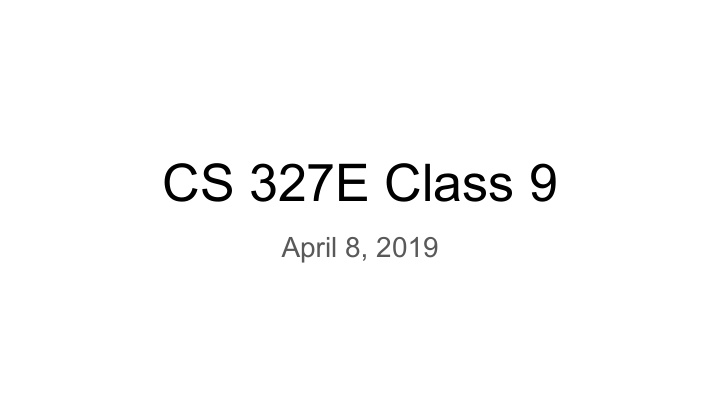



CS 327E Class 9 April 8, 2019
No Quiz Today :)
● What to expect from upcoming Milestones: Milestone 9: Find your secondary dataset, load into BQ and model the data with SQL transforms Milestone 10: Create Beam pipelines that transform the data Milestone 11: Create cross-dataset queries and data visualizations Milestone 12: Create workflow with Apache Airflow Milestone 13: Present and demo your project ● Review your secondary dataset today in class: http://tinyurl.com/y7d2jzjj
Questions: ● How likely are young tech companies to sponsor H1B workers? ● How does the compensation of H1B workers compare to that of domestic workers who are performing the same role and living in same region? Datasets: ● Main Dataset: H1B applications for years 2015 - 2018 (source: US Dept of Labor) ● Secondary Dataset: Corporate registrations for various states (source: Secretary of States) ● Secondary Dataset: Occupational Employment Survey for years 2015 - 2018 (source: Bureau of Labor Statistics)
Cross-Dataset Queries: ● Join H1B’s Employer table with the Secretary of State’s Corporate Registry table on the employer’s name and city. Get the age of the company from the incorporation date in the registry record. Group the employers into age buckets to see how many young tech companies sponsor H1B workers. ● Technical challenges: 1) matching employers within the H1B dataset due to inconsistent spellings of the company’s name 2) matching employers across H1B and Corporate Registry datasets due to inconsistent spellings of the company’s name and address.
Main Dataset
Raw Table Stats Year Table Size # Rows # Columns 2015 241 MB 618,804 41 2016 233 MB 647,852 41 2017 253 MB 624,650 52 2018 283 MB 654,162 52
Source File: https://github.com/shirleycohen/h1b_analytics/blob/master/h1b_ctas.sql
● Normalizes the employer name, city and state ● Removes duplicate employer records Source Files: https://github.com/shirleycohen/h1b_analytics/blob/master/transform_employer_table_single.py https://github.com/shirleycohen/h1b_analytics/blob/master/transform_employer_table_cluster.py
● Read the records from the Employer and Job/Application tables in BigQuery and create a PCollection from each source ● Normalize the employer’s name, city and state from the Job/Application PCollection (using ParDo ) ● Join the Job/Application and Employer PCollections on employer’s name and city (using CoGroupByKey ). ● Extract the matching employer_id from the joined results and add it to the Job/Application element (using ParDo ) ● Remove employer’s name and city from the Job/Application PCollections (using ParDo ) ● Write new Job/Application table to BigQuery Source Files: https://github.com/shirleycohen/h1b_analytics/blob/master/transform_job_table_cluster.py https://github.com/shirleycohen/h1b_analytics/blob/master/transform_application_table_cluster.py
Secondary Dataset
Table Details
Source File: https://github.com/shirleycohen/h1b_analytics/blob/master/corporate_registrations_ctas.sql
Source File: https://github.com/shirleycohen/h1b_analytics/blob/master/transform_corpreg_table_cluster.py
● ● ● ● ● Source File: https://github.com/shirleycohen/h1b_analytics/blob/master/employer_views.sql
http://www.cs.utexas.edu/~scohen/milestones/Milestone9.pdf
Recommend
More recommend